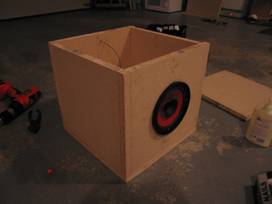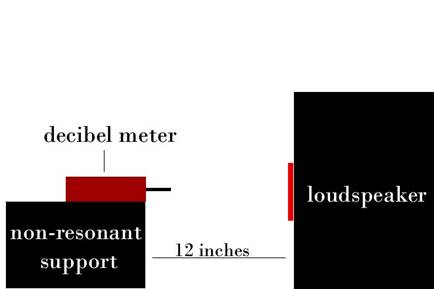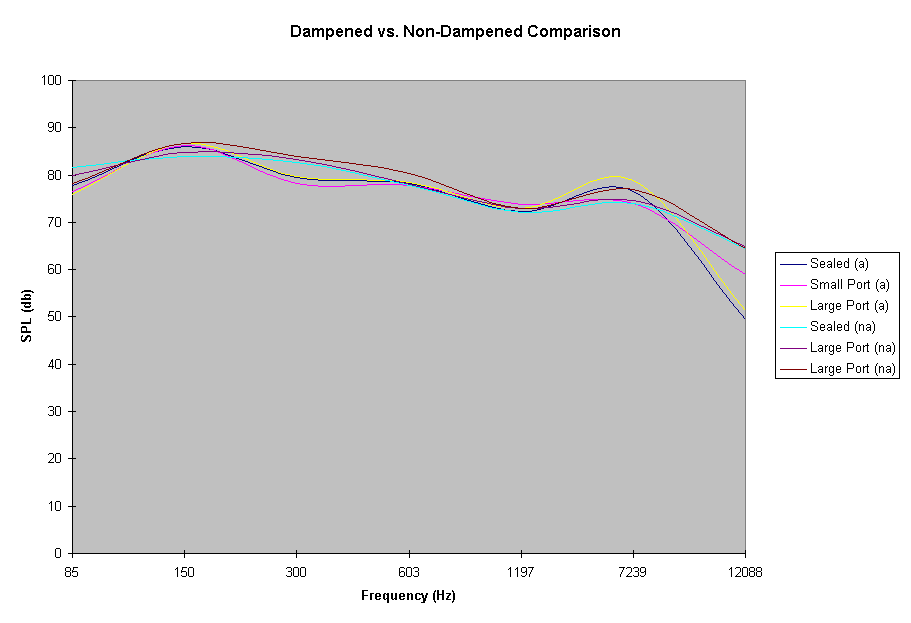The Effect of Ports and Acoustic Foam
on Frequency Range of a Loudspeaker
By: Matt McGrath and Marraja Saar
------------------------------------------------------------------------------------------
2 – Statement of Problem/Review of Literature
3 – Hypothesis
4 – Method
5 – Results
6– Graphs
7– Discussion
8– Bibliography
9- Links
10- Return to Research
(Click on titles to return to the beginning.)
------------------------------------------------------------------------------------------
Background : Loudspeakers are one of the most commonly used electronic devices in United States culture, and can be found in almost every home across the nation. A driver, the main component of a loudspeaker, simply reproduces sound by vibrating a diaphragm to create sound waves, which basically is the opposite of our ear drums, which vibrate in response to sound waves. A driver is comprised of a diaphragm, surround, basket, voice coil, and magnet. When a charge is induced on the voice coil, which is a wound metal cylinder, it is repelled by the similarly charged magnet, and moves the diaphragm outwards. When the charge is reversed, the coil is attracted to the magnet, and the diaphragm moves back. This design is very efficient and can produce very accurate results, however the driver itself is only part of what makes a good loudspeaker. The enclosure in which the driver is housed can make a marked difference on the efficiency and accuracy of the driver. Two common designs for enclosures are sealed and ported. A sealed enclosure has a constant amount of air inside it, and the pressure fluctuates as the driver moves in and out. The advantage to this design is that the pressure of the enclosure forces the driver make to its original position at rest, making it more accurate in its sound reproduction. The drawback is that the power amplifier must work harder to overcome the pressure inside the enclosure to move the driver forward and back. A ported enclosure usually has a tube inside that directs air in and out of the cabinet in response to the driver's movement. This design is must more efficient because there is no pressure to overcome, however it's not as accurate because the driver does not always return to the same position each time. In addition to the design of the enclosure is the material in which it's made. Typical consumer loudspeakers are made of MDF, or Medium Density Fiberboard . This composite material is light and strong, and fairly neutral in its acoustics, meaning that it does not excessively resonate at certain frequencies, which would change the speaker's accuracy. Finally, the acoustic treatment inside an enclosure can make a large difference in the sound production. An untreated cabinet with bare wood inside will reflect sound inside, and create unwanted resonances and phasing. Sound absorption material inside the cabinet will help reduce these reflections and provide a more accurate sound.
------------------------------------------------------------------------------------------
Statement of the Problem : The purpose of this investigation is to determine the degree to which ports, port size, and acoustic treatment changes the frequency response of a given loudspeaker.
Review of Literature : There are an amazing number of variables in loudspeaker design, ranging from materials of each component to the actual shape of the speaker. However, the researched literature will be limited to ports and acoustic treatment, and the effects they have on driver frequency response. One of the first pioneers of loudspeakers design, and the effect of the enclosure on it, was the team of Rice and Kellogg, who in 1925 designed the first hornless driver loudspeaker. In their research, putting a ported brass plate on the back of their enclosure improved their results [1]. The idea of enclosure design, while common knowledge now, is still extremely important in speaker design. The reason for this can be explained by HowStuffWorks.com; “ since the diaphragm is moving back and forth, it's actually producing sound waves behind the cone as well” [2]. This is why the design of the inside of the enclosure is just as important as the driver itself. Acoustic treatment such as foam is very important to controlling these waves behind the cone, and acoustic foam is “ designed to reduce sound by the…action of the passive absorption of the foam (effective at high frequencies)” [3]. Finally, ports will greatly change the overall response of a driver, since they are known “to extend the low frequency output of the loudspeakers system by exploiting Helmholtz resonator created by the compliance of the air inside the enclosure and iterance of the air in the port” [4]. This idea was further investigated by Vanderkooy, who discovered that “at high levels, ports produce jets of air, display acoustic compression, loss and distortion, generate turbulence noise, and rectify pressure fluctuations… flared ends and gentle tapering help somewhat” [5]. This means that the created port must be not only the correct size for the escaping air, as proven by Bohdan, but also be tapered, flared, and used at a relatively low level of SPL to avoid distortion and other unintended occurrences in the reproduced sound.
------------------------------------------------------------------------------------------
Hypothesis : We believe that a port will slightly increase SPL and low frequency response in response to its size, but will also display compression and change in SPLs of other frequencies, and that the addition of acoustic foam inside the enclosure will provide a more accurate reproduction of the sound, but have a less advantageous effect on the high frequencies, since it is relatively ineffective for LF (low frequency) absorption, but excellent at HF (high frequency) absorption.
------------------------------------------------------------------------------------------
Method: Our experimental setup consisted of two separate loudspeaker enclosures, an amplifier to power them, a signal generator, and a decibel meter.
The loudspeakers were built to be exactly identical except for the addition of sound-absorbing foam in one of them. Each were built out of ½” MDF, and then sealed with construction-grade caulking. The driver in each was an 8” paper-cone speaker rated at 80Hz-18kHz at 100 watts RMS.

The amplifier used was a 100-watt Yamaha power amplifier, attenuated to -30dB to avoid any clipping or distortion. The signal fed to the amplifier was from an iPod, on which 7 different sine waves were stored. (The sine waves were recorded using Pro Tools recording software, and converted to uncompressed .wav files. This approach was much more practical than moving the entire computer downstairs and feeding directly from the signal generator. The signals were recorded at 24-bit/96kHz quality). The decibel meter used was set to a “C” weighting scale, which is considered more accurate for flat frequency response (thus, any quantitative results from this investigation are technically known as decibels C-weighted, or dBC, however we will simply refer to them with the abbreviation dB).
Each loudspeaker was placed on carpeting, as far away as possible from any solid, sound-reflecting surfaces. The decibel meter was placed on a soft, non-resonant support exactly 12” from the middle of the speaker cone. The particular sine wave in question was played for 30 seconds, and the decibel reading that remained stable the longest was used. After taking a reading of all 7 frequencies on each of the two speakers, a 1” port was drilled into the back of each loudspeaker. This port was exactly in the middle of the back of each enclosure. The test was again repeated. Then the 1” port was widened to 2”, again exactly in the center of the back of the enclosure. The test was again repeated.

------------------------------------------------------------------------------------------
Results: The
graphs of our results can be found below. As with any experiment, there were
some uncertainties. Attenuating the amplifier -30dB, while avoiding
distortion, may have adversely affected the frequency response of the
amplifier. Also, running the sine waves from an iPod instead of straight from
a signal generator might have changed the frequency it was producing, since it
had to be converted to a .wav format audio file. Lastly, the environment in
which the experiment was held, while not terrible, was certainly not optimal.
There may have been some acoustic interference by the room on our
measurements. We tried to the best of our ability to minimize these effects,
either by using non-resonant supports or by removing any
acoustically-reflective surfaces in the general area.
------------------------------------------------------------------------------------------
Discussion: Our hypothesis was partly supported. While the addition of ports did slightly increase overall sound pressure, it was actually the addition of acoustic foam to a sealed loudspeaker that made the biggest difference in frequency response when compared to a non-foam sealed loudspeaker.
As you can see on the graph “Dampened vs. Non-Dampened Comparison (Sealed)”, the difference between the two sealed enclosures is quite apparent. Our hypothesis that the foam will produce a more accurate sound was proven quite wrong. In fact it was the non-foam loudspeaker the had the overall flattest frequency response; the foam enclosure had a +3dB increase at 150Hz, a +2.5dB increase at 7239Hz, and an amazing -15.1dB drop at 12.008kHz. This is most likely due to the fact that acoustic foam absorbs sound quite well, but only at certain frequencies. Quite obviously it absorbed frequencies around 12kHz, which may have an inverse relationship with the amount of bass present on the graph, since the bass seems somewhat boosted in volume.
The size of the port did seem to have a subtle effect on the overall volume of the speaker, but did not seem to have a clear effect on certain frequencies. The non-foam enclosure seems to show an overall increase of .5dB to 1.5dB in volume over the entire response with a 2” port. The foam enclosure, however, only seems to show a gain of volume at 7239Hz. We assume this is due to the un-even absorption of frequencies by the foam. The 1” port had negligible effects on both speakers.
In conclusion, the addition of ports to a loudspeaker can increase volume, but only slightly. According to our research it seems to have little effect on frequency response. Foam, however, has a large impact on the frequency response and could be used in conjunction with ports for a more contoured response and increased output. The most accurate combination we found was a sealed non-foam enclosure.
Further tests could include testing the foam to see what frequencies it readily absorbs and observing the effect different sized enclosures has on response.
------------------------------------------------------------------------------------------
Media: Graphs
and Raw Data Spreadsheets (Excel Format)
Raw Data Text File
------------------------------------------------------------------------------------------
[1] Rice, C.W., Kellogg E.W. “Notes on the development of a new type of hornless loud speaker”. Convention of the A.I.E.E. 1925.
[2] "How Speakers Work". HowStuffWorks (http://www.howstuffworks.com). Harris, Tom. HowStuffWorks, Inc., 2005.
[3] Gentry, C.A. , Guigou, C., Fuller, C.R. “Smart foam for applications in passive–active noise radiation control”. The Journal of the Acoustical Society of America . April 1997.
[4] Raczynski, Bohdan. “How good is your port?” . audioXpress . September 2001.
[5] Vanderkooy, J. Nonlineraraities in Loudspeaker Ports. AES preprint 4748. April 1998.
------------------------------------------------------------------------------------------
Speakerbuilding.com - DIY tips for building loudspeakers
HowStuffWorks.com - Explains the physics of speakers
Good Sound - Details of speaker construction
Audioholics - More DIY info
Bag End Speakers - The only professional speakers to have response to 8Hz